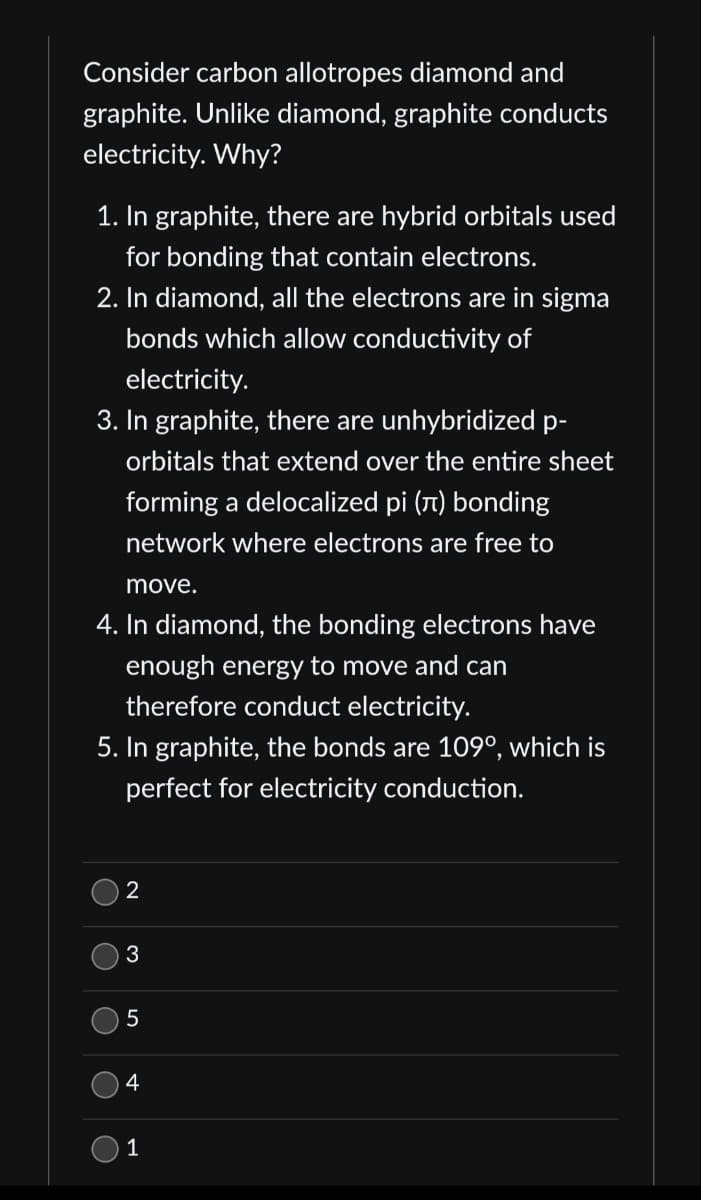Consider carbon allotropes diamond and graphite. Unlike diamond, graphite conducts electricity. Why? 1. In graphite, there are hybrid orbitals used for bonding that contain electrons. 2. In diamond, all the electrons are in sigma bonds which allow conductivity of electricity. 3. In graphite, there are unhybridized p- orbitals that extend over the entire sheet forming a delocalized pi (1) bonding network where electrons are free to move. 4. In diamond, the bonding electrons have enough energy to move and can therefore conduct electricity. 5. In graphite, the bonds are 109°, which is perfect for electricity conduction.
Consider carbon allotropes diamond and graphite. Unlike diamond, graphite conducts electricity. Why? 1. In graphite, there are hybrid orbitals used for bonding that contain electrons. 2. In diamond, all the electrons are in sigma bonds which allow conductivity of electricity. 3. In graphite, there are unhybridized p- orbitals that extend over the entire sheet forming a delocalized pi (1) bonding network where electrons are free to move. 4. In diamond, the bonding electrons have enough energy to move and can therefore conduct electricity. 5. In graphite, the bonds are 109°, which is perfect for electricity conduction.
Chemistry for Engineering Students
4th Edition
ISBN:9781337398909
Author:Lawrence S. Brown, Tom Holme
Publisher:Lawrence S. Brown, Tom Holme
Chapter8: Molecules And Materials
Section: Chapter Questions
Problem 8.97PAE: 8.97 The doping of semiconductors can be done with enough precision to tune the size of the band gap...
Related questions
Question

Transcribed Image Text:Consider carbon allotropes diamond and
graphite. Unlike diamond, graphite conducts
electricity. Why?
1. In graphite, there are hybrid orbitals used
for bonding that contain electrons.
2. In diamond, all the electrons are in sigma
bonds which allow conductivity of
electricity.
3. In graphite, there are unhybridized p-
orbitals that extend over the entire sheet
forming a delocalized pi (л) bonding
network where electrons are free to
move.
4. In diamond, the bonding electrons have
enough energy to move and can
therefore conduct electricity.
5. In graphite, the bonds are 109°, which is
perfect for electricity conduction.
O
()
()
2
3
5
4
1
Expert Solution
This question has been solved!
Explore an expertly crafted, step-by-step solution for a thorough understanding of key concepts.
Step by step
Solved in 3 steps

Knowledge Booster
Learn more about
Need a deep-dive on the concept behind this application? Look no further. Learn more about this topic, chemistry and related others by exploring similar questions and additional content below.Recommended textbooks for you

Chemistry for Engineering Students
Chemistry
ISBN:
9781337398909
Author:
Lawrence S. Brown, Tom Holme
Publisher:
Cengage Learning

Chemistry & Chemical Reactivity
Chemistry
ISBN:
9781337399074
Author:
John C. Kotz, Paul M. Treichel, John Townsend, David Treichel
Publisher:
Cengage Learning

Chemistry & Chemical Reactivity
Chemistry
ISBN:
9781133949640
Author:
John C. Kotz, Paul M. Treichel, John Townsend, David Treichel
Publisher:
Cengage Learning

Chemistry for Engineering Students
Chemistry
ISBN:
9781337398909
Author:
Lawrence S. Brown, Tom Holme
Publisher:
Cengage Learning

Chemistry & Chemical Reactivity
Chemistry
ISBN:
9781337399074
Author:
John C. Kotz, Paul M. Treichel, John Townsend, David Treichel
Publisher:
Cengage Learning

Chemistry & Chemical Reactivity
Chemistry
ISBN:
9781133949640
Author:
John C. Kotz, Paul M. Treichel, John Townsend, David Treichel
Publisher:
Cengage Learning